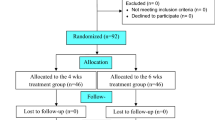Summary
Fifty-five ambulatory children with early culture-proven pertussis were treated for two weeks either with erythromycin ethylsuccinate (n=28) (50–80 mg/kg/day in three doses during meals) or with co-trimoxazole (n=27) (6–10 mg trimethoprim/kg/day in two doses after meals). After completion of treatment, all patients in the erythromycin group were culture-negative, while in the co-trimoxazole group one child was still culture-positive. In this case vomiting may have played a role. Both agents appear to be able to eradicateBordetella pertussis from the nasopharynx of patients with early whooping cough.
Zusammenfassung
Fünfundfünfzig ambulante Kinder mit kulturell bestätigtem Keuchhusten im Frühstadium wurden zwei Wochen lang entweder mit Erythromycin-Äthylsuccinat (n=28) (50–80 mg/kg/Tag in drei Einzeldosen während der Mahlzeiten) oder mit Co-trimoxazol (n=27) (6–10 mg Trimethoprim/kg/Tag in zwei Einzeldosen nach den Mahlzeiten) behandelt. Nach Therapieende waren alle Patienten in der Erythromycin-Gruppe kulturnegativ, während bei einem Kind in der Co-trimoxazol-Gruppe die Kultur noch positiv war. In diesem Fall hat möglicherweise Erbrechen eine Rolle gespielt. Beide Testmedikamente scheinen in der Lage zu sein,Bordetella pertussis aus dem Nasopharynx von Patienten mit frühem Keuchhusten zu eliminieren.
Similar content being viewed by others
Literature
Bass, J. W. Erythromycin for treatment and prevention of pertussis. Pediatr. Infect. Dis. 5 (1986) 154–157.
Trollfors, B. Whooping cough — aspects of pathogenesis and treatment. Acta Otolaryngol. Suppl. 407 (1984) 33–39.
Ginsburg, C. M. Pharmacology of erythromycin in infants and children. Pediatr. Infect. Dis. 5 (1986) 124–129.
Hoppe, J. E., Haug, A. Antimicrobial susceptibility ofBordetella pertussis. Infection 16 (1988) 126–130.
Hoppe, J. E., Haug, A. Treatment and prevention of pertussis by antimicrobial agents. Infection 16 (1988) 148–162.
Henry, R. L., Dorman, D. C., Skinner, J. A., Mellis, C. M. Antimicrobial therapy in whooping cough. Med. J. Aust. 2 (1981) 27–28.
Lennette, E. H., Balows, A., Hausler, Jr., W. J., Shadomy, H. J. Manual of clinical microbiology, Fourth edition. ASM, Washington 1985, pp. 967–977.
Imaizumi, A., Suzuki, Y., Ono, S., Sato, H., Sato, Y. Effect of heptakis (2,6-0-dimethyl)β-cyclodextrin) on the production of pertussis toxin byBordetella pertussis. Infect. Immun. 41 (1983) 1138–1143.
Stainer, D. W., Scholte, M. J. A simple chemically defined medium for the production of phase IBordetella pertussis. J. Gen. Microbiol. 63 (1971) 211–220.
Hagedorn, H.-J., Wirsing von König, C.-H., Kraminer-Hagedorn, A., Tacken, A., Diekmann, U.: Sensitivity testing ofBordetella pertussis in heptakis-supplemented Stainer-Scholte medium. ICAAC, 23–26 Oktober 1988, Los Angeles, USA, poster P 1219.
Eriksson, M., Bolme, P., Blennow, L. Absorption of erythromycin from pediatric suspension in infants and children. Scand. J. Infect. Dis. 13 (1981) 211–215.
McCracken, G. H., Ginsburg, C. M., Clahsen, J. C., Thomas, M. L. Pharmacologic evaluation of orally administered antibiotics in infants and children: effect of feeding on bioavailability. Pediatrics 62 (1975) 738–743.
Dwight, J. H., Hensey, D. M., Beyer, J. M., Vojtko, C., McDonald, E. J., Fernandes, P. B. Comparativein vitro activities of new 14-, 15-, and 16-membered macrolides. Antimicrob. Agents Chemother. 32 (1988) 1710–1719.
Kurzynski, T. A., Boehm, D. M., Rott-Petri, J. A., Schell, R. F., Allison, P. E. Antimicrobial susceptibilities ofBordetella species isolated in a multicenter pertussis surveillance project. Antimicrob. Agents Chemother. 32 (1988) 137–140.
Brun, Y., Forey, F., Gamondes, J. P., Tebib, A., Brune, J., Fleurette, J. Levels of erythromycin in pulmonary tissue and bronchial mucus compared to those of amoxycillin. J. Antimicrob. Chemother. 8 (1981) 459–466.
Preston, D. A. Microbiological aspects of erythromycin. Pediatr. Infect. Dis. 5 (1986) 120–123.
Bass, J. W., Crast, F. W., Kotheimer, J. B., Mitchell, I. A. Susceptibility ofBordetella pertussis to nine antibiotics. Am. J. Dis. Child. 117 (1969) 276–280.
Field, L. H., Parker, C. D. Antibiotic susceptibility testing ofBordetella pertussis, Am. J. Clin. Path. 74 (1980) 312–316.
Zackrisson, G., Brorson, J. E., Krantz, I., Trollfors, B. In vitro sensitivity ofBordetella pertussis. J. Antimicrob. Chemother. 11 (1983) 407–411.
Eichenwald, H. F. Adverse reactions to erythromycin. Pediatr. Infect. Dis. 5 (1986) 147–150.
Bergquist, S. O., Bernander, S., Dahnsjö, H., Sudelöf, B. Erythromycin in the treatment of pertussis: a study of bacteriologic and clinical effects. Pediatr. Infect. Dis. 6 (1987) 458–461.
Hoppe, J. E., Haug, A., Botzenhart, K. Susceptibility ofBordetella pertussis andBordetella parapertussis to twenty-four antibiotics. Chemotherapy 33 (1987) 250–254.
Salter, A. J. Trimethoprim-sulfamethoxazole: an assessment of more than 12 years of use. Rev. Infect. Dis. 4 (1982) 196–236.
Hughes, D. T. D., Bye, A., Hodder, P. Levels of trimethoprim and sulphamethoxazole in blood and sputum in relation to treatment of chest infections. In:Hejzlar, M., Semonsky, M., Masak, S. (eds.): Advances in antimicrobial and antineoplastic chemotherapy I, 2. Urban & Schwarzenberg, Munich 1972, pp. 1105–1106.
Adcock, K. H., Reddy, S., Okubadejo, O. A., Montefiore, D. Trimethoprim/sulphamethoxazole in pertussis: comparison with tetracycline. Arch. Dis. Child. 47 (1972) 311–313.
Arneil, G. C., McAllister, T. A. Whooping cough in infants: antimicrobial prophylaxis? Lancet II (1977) 33–34.
Cullen, A. S., Cullen, H. B. Whooping cough: prophylaxis with co-trimoxazole, Lancet I (1978) 556.
Huovila, R. The effect of early erythromycin treatment on the infectiousness of whooping cough patients. Acta Paediatr. Scand. Suppl. 298 (1982) 10–12.
Weber, E., Jacubeit, T., Auwärter, A., Ding, R., Gutzler, F., Mörike, K., Walter-Sack, I. Clinical and practitioners' reports on adverse effects of co-trimoxazole. Infection 15 Suppl. 5 (1987) 241–247.
Rabo, E. Drug prophylaxis in pertussis. Lancet II (1977) 707–708.
Author information
Authors and Affiliations
Rights and permissions
About this article
Cite this article
Hoppe, J.E., Halm, U., Hagedorn, H.J. et al. Comparison of erythromycin ethylsuccinate and co-trimoxazole for treatment of pertussis. Infection 17, 227–231 (1989). https://doi.org/10.1007/BF01639525
Received:
Accepted:
Issue Date:
DOI: https://doi.org/10.1007/BF01639525




